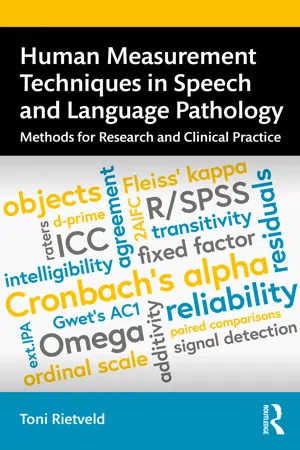
Human Measurement Techniques in Speech and Language Pathology
Methods for Research and Clinical Practice
Rietveld Toni
- 232 páginas
- English
- ePUB (apto para móviles)
- Disponible en iOS y Android
Human Measurement Techniques in Speech and Language Pathology
Methods for Research and Clinical Practice
Rietveld Toni
Información del libro
Human Measurement Techniques in Speech and Language Pathology gives an overview of elicitation methods in the assessment and diagnosis of speech and language disorders and explains approaches to the qualification of the obtained data in terms of agreement and reliability.
Despite technological advances in the assessment and diagnosis of speech and language disorders, the role of human judgements is as important as ever. Written to be accessible to students, researchers and practitioners alike, the book not only provides an overview of elicitation procedures of human judgement such as visual analog scaling, Likert scaling etc. but also presents methodological and statistical approaches to quality assessment of judgements. The book introduces statistical procedures for processing scores obtained in paired comparisons and in the context of signal detection theory, and introduces software relevant for the calculation of a large number of coefficients of reliability and agreement.
Featuring a wealth of reader-friendly pedagogy throughout, including instructions for using SPSS and R software, clarified by many illustrations and tables, example reports, and exercise questions to test the readers understanding, it is an ideal companion for advanced students and researchers in the field of speech pathology.
Preguntas frecuentes
Información
1
Measuring in speech pathology
1.1 What is measuring?
- Measure is a unit by which an object or process is measured. Examples of measures include Hz (hertz, number of oscillations per second) and hPa (hectopascal, pressure in weather systems or in the oral cavity).
- Measuring is the activity of obtaining data by using a measure. Examples include measuring pitch in Hz with a pitch algorithm and judging perceived nasality by using a scale ranging from 0 to 10.
- Measurement is the result of measuring.

1.2 Validity, sensitivity, reliability and agreement
- The informativity of the measurements: e.g. a two-alternative forced choice between ‘good’ or ‘bad’ is less informative than a scale ranging from 1 to 10.
- The ease of the task for the raters: e.g. giving an absolute judgement on a scale is often more difficult than a task which involves making paired comparisons such as ‘A is different from B,’ ‘A is better than B,’ etc.
- The cognitive load of the task: the extent to which cognitive processing resources, e.g. memory, are involved in the task.
- The statistical analysis of the data: the availability of procedures with which the data can be analyzed in such a way that the research question can be answered.
- The expected validity and sensitivity of the measurement instrument, the reliability of the scores (= measurement without errors) and the agreement between (for instance) raters.
1.2.1 Validity
- Face validity: this type of validity is quite obvious: does the instrument at first sight look as if it measures the domain adequately? For example, the percentage of stuttered syllables is not a good measure of severity of aphasia.
- Construct validity: the association between the measurements which are meant to assess a domain and other measurements focusing o...